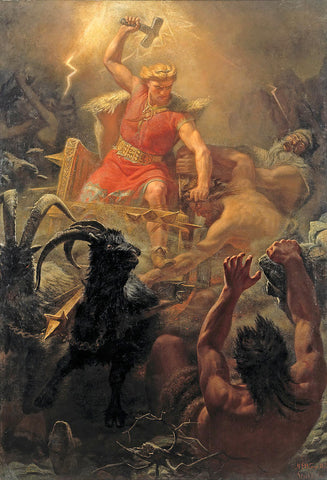Thor the God of Thunder In Norse Mythology
Thor was a powerful and popular Norse god in Viking life and culture. He was an important god among all branches of the Germanic peoples prior to their conversion to Christianity, however his popularity peaked among Norsemen and women in the late Viking age. Thor's Hammer was the symbol worn by his followers.
Thor, the God of Thunder, is the model of a trustworthy and honorable warrior, the ideal to whom the average Viking warrior and shield maiden aspired. He is the unflappable guardian of the Aesir gods and their realm from the encroachments of the giants, who are usually (but not always) the gods' foes.
Thor is the only one who is capable of performing these great feats of strength and prowess. His sense of responsibility and courage are unwavering, and his physical power is unrivaled. He even has an unnamed strength belt that increases his power by double when he wears it, but his hammer, Mjöllnir ("Lightning"), is his most famous possession. The Hammer of the Thunder God was forged by the great dwarf blacksmiths at the request of Loki who was trying to appease Thor after cutting off his wife’s beautiful golden hair. Thunder was the essence of Thor for the pagan Vikings, and lightning was the manifestation of his hammer slaughtering giants as he rode across the sky in his goat-drawn chariot.
Jormungandr, the giant sea snake that encircles Midgard, the world of human civilization, is Thor's main foe. In one legend, while on a fishing excursion, he tries to drag Jormungandr out of the sea, but is only stopped when his huge partner cuts the fishing line out of fear. However, at Ragnarok, Thor and Jormungandr finally meet, and the two put an end to each other in an epic battle at the end of time.
Thor is three-quarters giant, which is ironic given his ever-vigilant guardianship of the ordered cosmos of pre-Christian northern Europe against the forces of chaos, destruction, and entropy symbolized by the giants. Odin, his father, is half-giant, while Jord (Old Norse "Earth"), Hlöyn, or Fjörgyn, his mother, is wholly of giant blood. However, such a lineage is widespread among the gods, demonstrating that the tense and tumultuous relationship between the gods and the giants cannot be reduced to mere animosity.
Thor’s feats of strength and destruction were mirrored by his human activities in Midgard, where he was sought out by persons seeking protection, consolation, and the blessing or hallowing of places, things, and events. Many surviving runic inscriptions ask him to hallow the words and their intended meanings, and it was he who was asked to bless weddings, births and other major events in Viking life. Evidence of this can be found in the story of Thor Disguised as a Bride. Also, before they erected structures or grew crops, the earliest Icelandic settlers begged him to hallow their plot of land.
Thor's hammer could be used to purify as well as destroy and, in effect, these two abilities were one and the same, because any purification entails the expulsion of evil forces or giants. Wedding blessings, for example, were performed with his hammer. In one story, Thor is said to kill and consume the goats that pull his chariot, gather their bones in their hides, bless the hides with the hammer, and bring the animals back to life, as healthy and vibrant as before.
Thor played an important part in the development of agriculture and fertility, in addition to his duty as a model warrior and defender of society's order and objectives. This was another aspect of his job as a sky god, and one that was particularly linked to the rain that allows crops to thrive. "Thor, they say, presides over the air, which rules thunder and lightning, winds and rains, fair weather and crops," writes Adam of Bremen, an eleventh-century German historian. Sif, his rarely mentioned wife, is known for her golden hair, which is unmistakably a sign for grain fields. Their union is thus an example of what religion historians refer to as "hierogamy", a divine marriage, which typically occurs between a sky god and an earth goddess, especially among Indo-European peoples. The sexual union of sky and earth is responsible for the land's fertility and, by extension, the people's wealth.
The adoration of Thor can be traced back to the Bronze Age by archaeological evidence, and his cult has undergone countless transformations through time and place. Thor's role as the major deity of warriors and military might among Viking people as well as his popularity at major life events remained consistent from the Bronze Age to the Viking Age. As a result, he became the most powerful god among the common people in Scandinavia and their viking colonies.
See our Viking Jewelry Collections here
By contrasting Thor with Odin, the deity who was almost his functional opposite, this role becomes evident. Odin was the most popular deity among kings, outcasts, and "elite" people of all kinds. Odin's major values are ecstasy, wisdom, magical might, and creative agency, all of which are extremely rare. They contrast sharply with Thor's more domestic traits. As a result, the Viking sagas portray the relationship between the two gods as frequently tense. "Odin's are the nobles who perish in combat, while Thor's are the thralls," Odin taunts Thor at one point. In another episode, Odin bestows blessings on Starkar, a favorite hero of his, and each blessing is accompanied by a curse from Thor. In the most revealing example, Odin bestows the respect of the aristocracy and rulers on Starkar, yet Thor declares that he will always be despised by the common people.
Throughout the Viking Age, the significance of Thor appears to have increased at the expense of Odin. Thor is described as the most powerful of all the Aesir in late period sources, a claim that would have seemed absurd before the Viking Age, when Odin and his Anglo-Saxon counterparts held this status.
This trend was most noticeable in Iceland, which was founded in the ninth century by farming colonists fleeing the oppressive and arbitrary authority of an Odin-worshiping Norwegian monarch. The sagas are full of examples of the Icelanders' devotion to Thor, and nearly a quarter of the people named in the Landnámabók, the Icelandic "Book of Settlements," have Thor's name or a clear allusion to him elsewhere in their names. In these Viking Age texts, Thor emerges not only as the primary deity of the settlers but also as patron and guardian of the settlement itself, of its stability and law.

Another factor for the rise in Thor worship during the Viking Age is that there was an increase in the number of people who believed in him. When Christianity first arrived in Scandinavia and the Viking colonies, the locals tolerated the new god's religion in the same way they tolerated any other god's cult.
The northern Europeans retaliated when it became clear that the Christians had no intention of extending the same tolerance to those who continued to worship the old gods, but rather wanted to eradicate the traditional religion of northern Europe and its accompanying way of life and replace it with a foreign religion. And who better than Thor to protect their traditional way of life and worldview against invading forces? Modes of dress were one of the many areas of life where this battle revealed itself and one of the easiest to trace using current anthropological methodologies.
Those who continued to follow the ancient traditions began to wear small Thor's hammers around their necks, in stark contrast to the cross amulets that Christians wore around their necks. Archaeological finds of these hammer pendants have been concentrated in places where Christian influence was most apparent. Despite the fact that they were ultimately doomed, their efforts to preserve their ancestral traditions were undoubtedly aided by the divine patron who served as a role model. Like paganism, Thor the Thunder God was also fated to die in the great battles of Ragnarok, but not before defeating his greatest enemy Jormungand the World Serpent.
See our entire collection of Thor Viking Jewelry and Gifts. Get a great Viking bracelet, Viking rings or a Viking arm ring.












